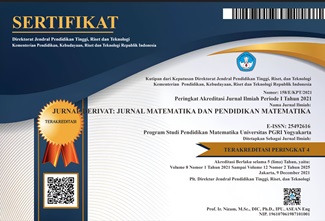Etnomatematika: Eksplorasi Konsep Geometri Pada Bangunan Masjid Muhammad Cheng Hoo Purbalingga
DOI:
https://doi.org/10.31316/jderivat.v11i1.5881Abstract
There is a big difference between the mathematics problems taught in school and the mathematics that exists in society. As a result, educators face difficulties in modeling formal mathematical concepts with mathematical problems that occur in everyday life. By connecting mathematics learning with culture it will help the learning process. This will make it easier for educators to understand the topics being studied because they are relevant to everyday life. The aim of this research is to explore the concept of geometry in the Muhammad Cheng Hoo Purbalingga mosque. Data collection methods use interviews, observation and documentation. The camera is the tools and materials used. The data presentation is given in the form of images, along with a description of the ethnomathematics values that exist in the mosque. This research shows that the Muhammad Cheng Hoo Mosque in Purbalingga combines three cultural elements, namely Chinese, Arabic and Javanese. The results of this research show that the Muhammad Cheng Hoo mosque contains geometric elements, namely flat shapes, spatial shapes and transformations. This research is recommended for use as mathematics learning material.
Keywords: Mathematics, Ethnomathematics, Muhammad Cheng Hoo Mosque
References
Aprianti, S. N., Rusmana, I. M., & Setiadi, A, (2023). Etnomatematika Pada Kestabilan Suatu Bade di Bali. Prosiding Diskusi Panel Nasional Pendidikan Matematika, 455-464.
Fauzi, Asri & Setiawan, Heri. (2020). Etnomatematika: Konsep Geometri pada Kerajinan Tradisional Sasak dalam Pembelajaran Matematika di Sekolah Dasar. Didaktis: Jurnal Pendidikan dan Ilmu Pengetahuan. 20. 10.30651/didaktis.v20i2.4690.
Hanik, Umi & Edy Nurtamam, Mohammad. (2017). INTEGRASI ETNOMATEMATIKA DALAM PEMBELAJARAN MATEMATIKA SEKOLAH DASAR. 10.31219/osf.io/724b6.
Janan, Tuhfatul. (2022). Eksplorasi Matematika Pada Masjid Raya Bandung. Jurnal Equation: Teori dan Penelitian Pendidikan Matematika. Vol.5, No.2
Khaqiqi, Faizal. 2022. Etnomatematika pada Bangunan Masjid Muhammad Cheng Hoo di Purbalingga Sebagai Sumber Belajar Geometri. Purwokerto: Universitas Islam Negeri Prof. K.H. Saifuddin Zuhri. (Skripsi)
Lukito, Agung. 2018. Buku Siswa Matematika Kelas IX. Jakarta: Kementerian Pendidikan dan Kebudayaan
Manullang, Sudiyanto. 2017. Buku Siswa Matematika Kelas XI. Jakarta: Kementerian Pendidikan dan Kebudayaan.
Murtiawan, W, E., Rara, K. (2020). Eksplorasi Konsep Etnomatematika Geometri pada Bangunan Pura. Jurnal Pembelajaran Berpikir Matematika. Vol.5, No.2, 86-95.
Pujangga, A, C. (2020). ETNOMATEMATIKA PADA MASJID MUHAMMAD CHENG HOO JEMBER SEBAGAI BAHAN PEMBELAJARAN GEOMETRI. Jember: Universitas Jember. (Skripsi)
Putra, R. Y., Alviyan, D. N., Arigiyati, T. A., & Kuncoro K. S. (2021). Etnomatematika pada bangunan Umbul Binangun Taman Sari dalam pembelajaran matematika materi geometri bidang datar. Ethnomathematics Journal, 2(1), 21-30.
Turmuzi, M. (2022). Meta Analisis: Pengaruh Pembelajaran Berbasis Etnomatematika terhadap Hasil Belajar Matematika Siswa. JPMI – Jurnal Pembelajaran Matematika Inovatif, 5 (5), 1525-1534.
Wardhani, Indah Setyo. (2020) Geometri Dan Permasalahannya Dalam Pembelajaran Matematika di Sekolah (Suatu Penelitian Meta Analisis). Prosiding SI MaNIs (Seminar Nasional Integrasi Matematika dan Nilai-Nilai Islami). Vol. 1, No. 1.
Widya Saviraningrum, Wahidin. (2023). EKSPLORASI ETNOMATEMATIKA PADA MASJID AGUNG KOTA TASIKMALAYA. Jurnal Ilmiah Pendidikan Matematika, Matematika dan Statistika. Vol. 4, No. 2, 748-763.
Yudianto, Erfan & Febriyanti, Rizka & Mpd, Sunardi & Sugiarti, Titik & Mutrofin, Mutrofin. (2021). Eksplorasi etnomatematika pada Masjid Jami' Al-Baitul Amien Jember. Ethnomathematics Journal. 2. 11-20. 10.21831/ej.v2i1.36329.
Zaenuri., Nurkaromah, D., Amin, S. (2018). PEMBELAJARAN MATEMATIKA MELALUI PENDEKATAN ETNOMATEMATIKA (Studi Kasus Pembelajaran Matematika di China). Semarang: UNNES Press.
Downloads
Published
Issue
Section
Citation Check
License
Copyright (c) 2024 Latifah Fitriana Rahmah

This work is licensed under a Creative Commons Attribution-ShareAlike 4.0 International License.
Authors who publish with this journal agree to the following terms:
-
Authors retain copyright and grant the journal right of first publication with the work simultaneously licensed under a Creative Commons Attribution-ShareAlike 4.0 International License that allows others to share the work with an acknowledgment of the work's authorship and initial publication in this journal.
- Authors are able to enter into separate, additional contractual arrangements for the non-exclusive distribution of the journal's published version of the work (e.g., post it to an institutional repository or publish it in a book), with an acknowledgment of its initial publication in this journal.
- Authors are permitted and encouraged to post their work online (e.g., in institutional repositories or on their website) prior to and during the submission process, as it can lead to productive exchanges, as well as earlier and greater citation of published work (See The Effect of Open Access).







